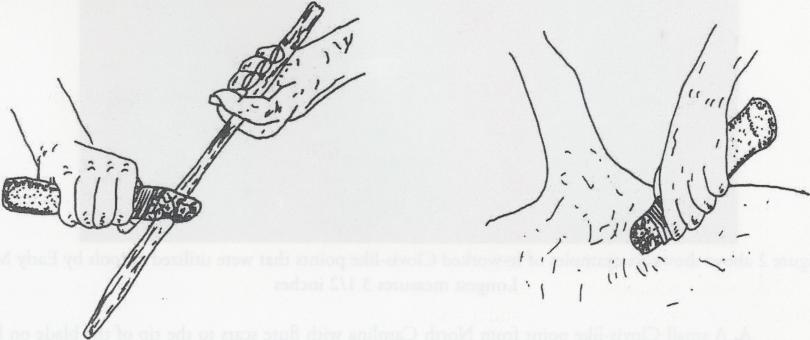by Rodney M Peck, Kannapolis, North Carolina
Originally Published in the Central States Archaeological Journal, Vol.56, No.4, pg.200Originally Published in the Central States Archaeological Journal, Vol.57, No.1, pg.26

Figure 1. Selection of Clovis-Like Projectile Points From North Carolina. Point in the middle imeasures 5 1/2
inches in length
PREFACE
This is a report about various Clovis-like fluted projectile points which gives evidence that they were utilized as special tools by Early Man. This study examines several specimens of re-worked Clovis points and gives the suggested functional analysis of each.
INTRODUCTION
Early Man arrived in North America using long, cylindrical spear points made of bone and ivory. These slender bone “needles” were the principal weapon for hunting both large and small game. As time passed these bone “needle” spear points were eventually replaced with a crude lithic projectile point known as the Haw River Point (or some type similar) and from it evolved the Clovis-like fluted point. But were all Clovis-like points used as spears or could they have served a multiple use-like knives, scrapers or other cutting instruments and, also as projectile points.
We know from the Vale Site, Shoop Site, Williamson Site, and other Paleo-Indian sites that Early Man had a specialized tool kit. However, if a hunter had to travel very far from home while searching for game it seems logical that he would select a few multipurpose tools to carry with him rather than his complete tool kit which he might use at his home base or main village site.
The basic job for the archaeologist is to study the lithic material Early Man left behind. He must interpret the use of their tools and come up with a functional analysis in how a particular artifact was used. When one examines the Clovis-like projectile points left by Early Man immediately he interprets them to be used as “projectile points”; however, when one observes the wear pattern on the cutting edges of the blade he can easily reason that a few specimens were probably used also as knives, drills, scrapers, spoke shaves or other types of cutting tools.
STUDY
When ones examine a classic Clovis-like point he can interpret the “use-wear” on the blade’s edge. Some like those in figure 1 will not show any re-worked flaking and these could be assumed to be used as projectile points. However, other specimens like those in figure 2, the Clovis-like points will definitely show wear along the cutting edge of the blade. This wear could be either in the form of crushing on the laterial edges or laterial retouching to facilitate the blade to be used as a knife of other specialized tool. A Clovis-like point could be used repeatedly for a variety of tasks. Some specimens could have been used for cutting wood (figure 3 and 5), butchering animals (figure 4), or scraping hides (figure 6). Other re-worked Clovis-like points could have been used for dicing roots and fruits; sawing bone, antler, or small saplings; for stripping bark; for cutting weeds and grasses; for the construction of a shelter; or for a rasp.


Figure 2 above shows six examples of re-worked Clovis-like points that were utilized as tools by Early Man: Longest measures 3 1/2 inches
A. A small Clovis-like point from North Carolina with flute scars to the tip of the blade on both faces. The left laterial edge has been re-worked to form a spokeshave for working wood and bone. See conjectural sketch in figure 5.
B. A re-worked North Carolina Clovis-like point. The entire tip of the blade of this specimen has been re-worked to form a hafted scraper for working animal hides. See conjectural sketch figure 6.
C. Another North Carolina Clovis-like point. This specimen was re-worked into a bi-facial knife which probably had similar use to example shown in figure 4.
D. A nicely made Clovis-like fluted point from North Carolina. The left edge of the blade appears to have been crushed and could possibly have been used as a cutting edge as shown in figure 3. The right laterial edge of the blade shows re-touching flakes that indicate it could have been used as a knife for butchering animals as shown in figure 4.
E. A nice Classic Clovis-like point from North Carolina which shows evidence of being re-worked on the left laterial edge of the blade which was also probably used to butcher animals as shown in figure 4.
F. A Clovis-like fluted point from Kentucky which was re-worked to be utilized as a drill or awl.


Figure 3. (Left) Conjectural sketch illustrating how a wear pattern of a knife might have developed.
Figure 4. (Right) Conjectural sketch illustrating how a re-worked Clovis-lke point might have been used in butchering animals.


Figure 5. (Left) Conjectual sketch illistrating how a spokeshave might have been used by early man.
Figure 6. (Right) Conjectural sketch illustrating how a hafted scraper might have been used in working animal hides.
CONCLUSION
In conclusion, this report has examined several Clovis-like projectile points that were made by Early Man and were re-worked into specialized tools. Some were remarkably similar while others were one-of-a-kind. As more of these “re-worked” Clovis points are studied by archaeologists in regards to their functional analysis they will help us interpret how Early Man lived and hunted in North America.”Used by Permission of the Author”
To learn more about or to join the Central States Archaeological Society, click here:CSASI.org
